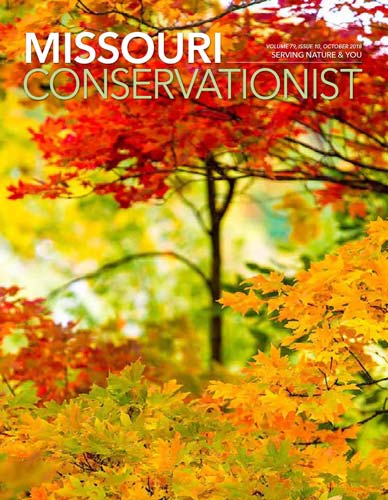Ever hear a warbler’s song and think, “What kind of plant is that?” According to biodiversity expert, Doug Tallamy, you should. In his 2007 book, Bringing Nature Home, Tallamy traces the return of springtime songbirds to the native trees that support the caterpillars they feed their babies. In fact, it takes 6,000 to 9,000 caterpillars to raise a nest of baby chickadees. Because of this vital tree-insect-songbird connection, simply planting and maintaining native trees can turn your yard or urban green space into a powerful force for conservation.
But how do homeowners and towns go about adding more native trees and shrubs to urban landscapes? MDC provides advice, resources, and support to help everyone take advantage of all that native trees and shrubs have to offer.
Teaching Residents About Trees
“I feel that my major job is to provide better habitat for humanity by using trees as a tool,” said Chuck Conner, MDC community forester in the Kansas City Region. “We’ve come to believe that we can live exclusively apart from nature, but the greener our environment, the better off we are socially, economically, and environmentally.”
As a community forester, one of Conner’s priorities is working with groups and organizations that receive funding from MDC to help improve their natural resources. Kansas City’s Heartland Tree Alliance (HTA), a program of that city’s nonprofit Bridging The Gap organization, is one of the entities he works with. “We used a grant for an educational Treekeepers program to teach residents about trees,” said Sarah Crowder, a certified arborist who serves as HTA’s program manager.
As part of the program, participants devote 18 hours to learn about soils, tree planting, and pruning, and then serve as HTA volunteers for the organization’s considerable public education efforts
HTA also has used MDC funding to install a native plant arboretum along the Blue River that includes educational signage as well as tree planting and pruning workdays. Participants gain on-the-job training in proper planting, mulching, and pruning techniques.
“MDC has been a good partner,” Crowder said.
Help for the St. Louis and Southwest regions
Erin Shank, an MDC urban wildlife biologist in the St. Louis Region, builds partnerships with parks, schools, neighborhood organizations, and other nonprofit organizations to improve urban habitat.
“We promote common objectives like removing nonnative and invasive species like winter creeper, garlic mustard, and bush honeysuckle, and replacing them with natives,” said Shank. “We encourage staff training of partner agencies and volunteerism in communities. It’s not enough to know and care.
You’ve got to do something about it.” One tool that she and her counterparts in the state’s southwest region can use in their communities is MDC’s Community Conservation Grant (CCG). “We have worked with the local chapter of the Audubon Society on a project with St. Louis County parks to convert turf into pollinator habitat, and in a St. Louis City park, to convert turf to native prairie species,” she said.
Shank said a CCG project at St. Louis’ Bellefontaine Cemetery — which holds arboretum status and employs three full-time horticulturalists — has been particularly successful. Founded as a small, rural cemetery in 1849, the city has grown up around it. “The work they’ve done increased their bird count from 117 species in 2014 to 134 species in 2015,” Shank said.
Kyle Cheesborough, Bellefontaine’s horticulture supervisor, said the fact the cemetery is located in a major migratory pathway jumped out at him when he began working there.
“Instead of planting begonias every year, we added shrub masses along with prairie-like areas to produce both thickets and grassy meadows for cover and nesting,” he said.
“In addition to that, we recognized a problem for waterfowl with hardscape walls all around the ponds. There was nowhere for chicks to get in and out of the water.”
Water lilies, planting shelves, and appropriate pond edge plantings were introduced. “We added four species of waterfowl to the count in one season. It was amazing. The birds felt safe nesting in the cover of the grasses,” he said.
In addition, native shrubs have been planted in masses to provide attractive screening as well as cover for smaller songbirds and berry meals for birds and other small animals.
Cheesborough, who has worked at Bellefontaine for four years, said he and other staff members pair diversity with aesthetics in their designs and plantings.
“We’re not purists, but we try for at least 70 percent native plants in every design,” he said, adding that there are plenty of attractive Missouri native plants to work with.
- Call your Community Forester Community foresters help local communities and residents care for their trees and forests.
TRIM for Healthy Community Trees
Another way MDC helps local communities choose and care for their trees is through the Tree Resource Improvement and Maintenance (TRIM) grant. MDC Community Forester Ann Koenig works in Columbia. She said TRIM grants cover the cost of having a certified third-party arborist map a project area, noting every tree species’ size, condition, and immediate needs before making any recommendations about what to plant.
“In some cases, a city has a large number of a single species, and we recommend they plant something else,” she said. “A diversity of species helps an urban forest resist disease, and a diverse forest supports more kinds of wildlife.”
Koenig is particularly concerned about communities with a large percentage of ash trees. “With the emerald ash borer (EAB) in the state, the workload for them will be devastating,” she said.
TRIM funds are available statewide, and they can help communities determine how best to cope with EAB. “Some ash trees can be saved with treatments, but others will have to be removed and replaced,” Koenig said. “TRIM funds can help with removal and replacement as well as training for staff so communities can better maintain their urban forests.”
All That Blooms is not Beneficial
“Native species have evolved together over thousands of years, forming mutual relationships,” said Jennifer Behnken, a community forester in MDC’s Southeast Region. “I try to recommend native trees as often as possible,” she said.
When making choices about what to plant, Behnken said that it also is important to avoid the pitfalls of introducing nonnative species that are now considered invasive in Missouri landscapes — Callery pear, Russian olive, autumn olive, golden rain tree, tree-of-heaven, and mimosa trees. Behnken explained why Callery pear, in particular, became such a problem. “At first, there were so few of them that they didn’t produce fruits, so they didn’t spread.”
Callery pear, also known as Bradford pear, tends to break apart in wind or ice storms, and Koenig is quick to offer good native alternatives. “Serviceberries and flowering dogwoods have pretty white flowers,” she said. “They’re small to medium-sized trees that produce colorful fruit that is good for birds.”
- Trees and Plants Learn about invasive tree pests, find guidance about tree planting and care, and learn more about how trees work for wildlife and people at mdc.mo.gov/ trees-plants.
Gather Resources and Make a Plan
MDC staff recommends going into any native landscape or urban forestry project with the right mindset: gather your resources, make a plan, do the work, and be patient. See the sidebars throughout this story for resources to help you begin thinking about adding native trees or improving your care for them.
In many cases, you will need to remove invasive trees, shrubs, and vines before replanting with natives. Before removal, make a plan for replacements. “If you remove honeysuckle,” Shank said, “what will immediately move in are the most aggressive plants.” She recommends promptly planting the cleared area with inexpensive annual native grasses that will re-seed and spread. “I use Virginia wild rye, Canada wild rye, river oats, and switchgrass, about 3–4 pounds to the acre.”
Consider adding shrubs, which make good habitat corridors along property and fence lines. Kyle Cheesborough recommends native shrubs with all-season beauty. “Black chokeberry is great planted in masses,” he said. “Coralberry and nannyberry provide berries, as does arrowwood viburnum, which also makes a nice specimen planting.”
Where you can, choose trees that support the native food chain. According to Tallamy, the white oak supports 410 kinds of butterfly and moth caterpillars that feed 17 species of native birds, and the black cherry supports 239 caterpillar species and 14 bird species.
Using native trees in residential landscapes can be as easy as planting a single oak tree to serve songbirds in the spring or as challenging and rewarding as becoming a treekeeper or encouraging your civic leaders to pursue TRIM funding to maintain your town’s community forest. Choose your level of commitment, explore your MDC resources, and dig in!
- TRIM for Community Tree Care Get up to $10,000 for help with managing, improving, or conserving your community’s trees. Applications are due the first Friday in June every year. Learn more at mdc.mo.gov/TRIM.
Wildlife-Friendly Trees and Shrubs
Small trees
These are good native alternatives to invasive Callery pear.
- Downy hawthorn With a 20- to 30-foot height and a 15- to 30-foot spread, it supports 150 butterfly and moth species.
- Downy serviceberry With a 15- to 30-foot height and 10- to 20-foot spread, it supports 119 butterfly and moth species.
- Flowering dogwood With a 15- to 20-foot height and 10- to 30-foot spread, it supports 115 butterfly and moth species.
Large trees
If your ash trees are declining, replace them with these hardy alternatives.
- Shagbark hickory With a 70-foot height and 45-foot spread, it supports 200 butterfly and moth species.
- Tulip poplar With a 70- to 90-foot height and 35- to 50-foot spread, it supports 368 butterfly and moth species.
- White oak With a height and spread of up to 50 feet, it supports more than 410 butterfly and moth species.
Shrubs
Use these native shrubs instead of invasive bush honeysuckles.
- American hazelnut With a 10-foot height and 8-foot spread, it supports 31 butterfly and moth species.
- Arrowwood viburnum With a 10-foot height and spread, it supports 104 butterfly and moth species.
- Ninebark With a 5- to 8-foot height and 4- to 6-foot spread, it supports 40 butterfly and moth species.
Songbird Gallery
What’s your favorite songbird? These birds need caterpillars and other insects to rear their young. Missouri native trees and shrubs provide the best host and food plants for the Show-Me State’s native moths, butterflies, and other land invertebrates.
- Acadian flycatcher
- Bell’s vireo
- Black-capped chickadee
- Summer tanager
- Eastern
- bluebird
- Painted bunting
- Baltimore oriole


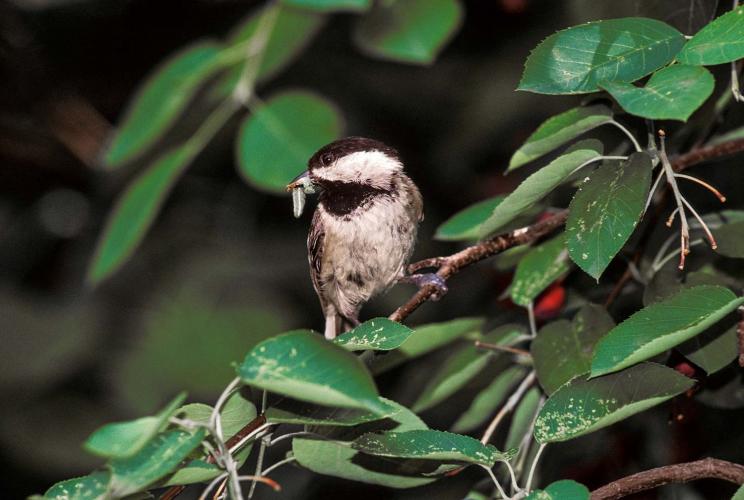
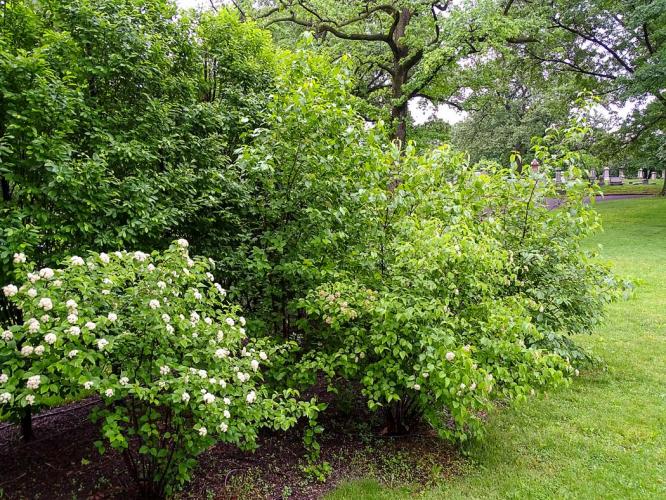

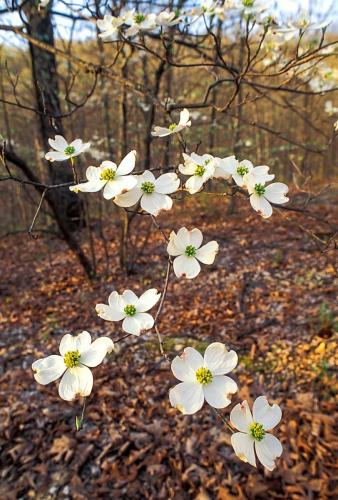







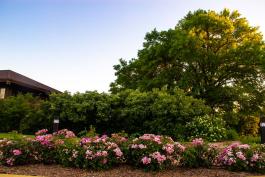







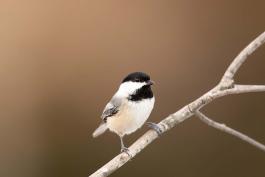



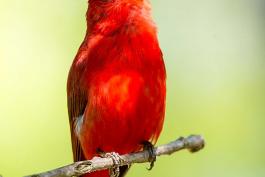
Also In This Issue
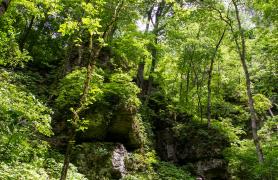
And More...
This Issue's Staff
Associate Editor - Bonnie Chasteen
Staff Writer - Larry Archer
Staff Writer - Heather Feeler
Staff Writer - Kristie Hilgedick
Staff Writer - Joe Jerek
Creative Director - Stephanie Thurber
Art Director - Cliff White
Designer - Les Fortenberry
Designer - Marci Porter
Photographer - Noppadol Paothong
Photographer - David Stonner
Circulation - Laura Scheuler






















